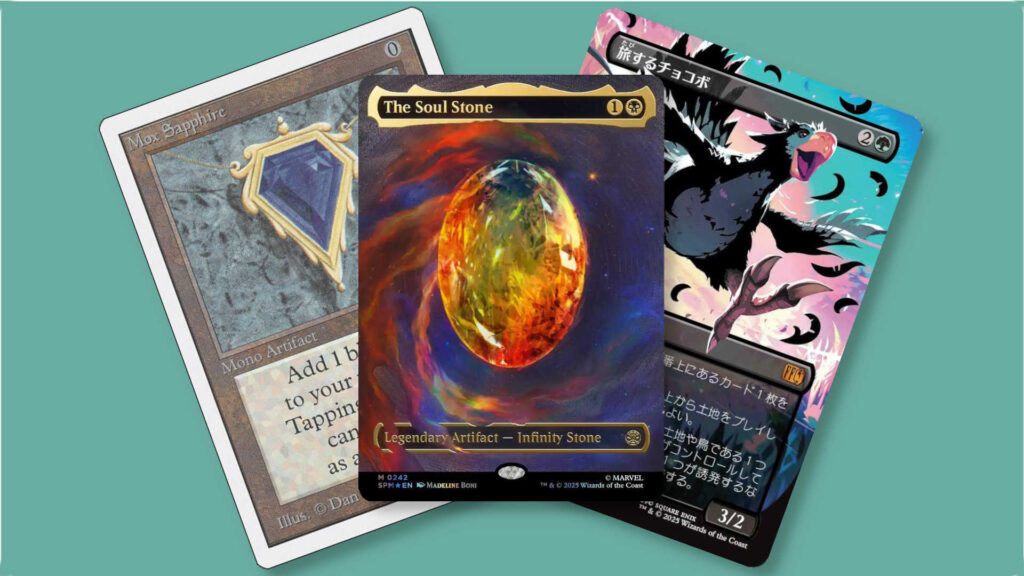Card scans sourced from https://www.legendarycardgame.com/
Marvel Legendary, from Upper Deck, is one of the greatest deck building games of all time. The game first released in 2012, and even now, 12 years later, several new expansions are still released for it every year. If you’re looking to learn how to play one of Marvel’s most popular games, here’s a handy guide to get you started.
Table of Contents
ToggleSetup for Marvel Legendary
The Marvel Legendary core set contains the following cards:
- 40 S.H.I.E.L.D. Agents
- 20 S.H.I.E.L.D. Troopers
- 30 S.H.I.E.L.D. Officers
- 15 Heroes – Every Hero has 14 different cards that represent them.
- 4 Masterminds – Every Mastermind has a card representing them, and 4 tactics cards.
- 7 Villain Groups – Villain Groups are made of 8 cards depicting several villains.
- 4 Henchman Groups – Every henchman group contains 10 cards.
- 8 Schemes
- 11 Scheme Twists
- 5 Master Strikes
- 30 Bystanders
- 30 Wounds
Here’s how you set everything up so that you’re ready for your first game.
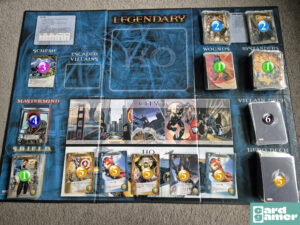
- Take all of the Bystander, Wound, and S.H.I.E.L.D. Officer cards and place them on their corresponding spaces on the game board. If you own any expansions that add special Wounds, Bystanders, or S.H.I.E.L.D. Officers then shuffle them into their respective piles and place them face down, otherwise place them face up.
- Make a Starter Deck for every player. These decks are composed of eight S.H.I.E.L.D. Agents and four S.H.I.E.L.D. Troopers. Shuffle the deck and draw six cards; this will be your starting hand.
- Choose any Scheme and place it on the “Scheme” space on the board. Read the setup instructions on your Scheme and see how many Scheme Twists it requires. Set aside that number of Scheme Twists, and return the rest to the box.
- Choose a Mastermind for your game. Place them on the Mastermind space, shuffle their four tactics and place them in a facedown pile underneath the Mastermind. The Mastermind card will specify that they always lead a particular group of Villains or Henchmen; take this group out of the box.
- Make the hero deck. Select five heroes that you want to use in your game. Every hero will have 14 cards representing them. Thoroughly shuffle the cards for each of your heroes together into a single deck. Place the resulting stack of cards on the Hero Deck section of the board facedown. Deal the top five cards of the Hero Deck out into the HQ space. (If you’re playing with five people, build the Hero Deck using six heroes instead of five.)
- Make the Villain Deck. Take the Scheme Twists and Villain group that you set aside earlier, add in the five Master Strikes and then add additional cards based on the table below.
| Number of Players | Total Number of Villain Groups | Henchman Groups | Bystanders |
| 2 | 2 | 1 | 2 |
| 3 | 3 | 1 | 8 |
| 4 | 4 | 2 | 8 |
| 5 | 5 | 2 | 16 |
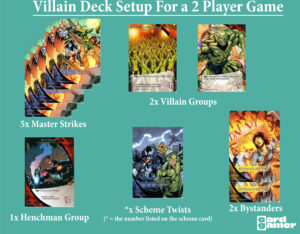
Shuffle these cards together to form the Villain Deck and place it on the Villain Deck space.
As an example, if you’re playing with two players, then the Villain Deck will contain:
Two Villain groups, the five Master Strikes, one Henchman group, two Bystanders, and the number of Scheme Twists listed on your Scheme card.
With all of that taken care of, you’re now ready to get playing.
Taking Turns in Marvel Legendary
Every turn in Marvel Legendary has the following steps:
- Draw a card from the Villain Deck.
- Play cards from your hand.
- Discard your hand and draw a new hand of six cards.
A player goes through these three steps on their turn, and then play passes to the next player in clockwise order who goes through the three steps and then passes to the next player.
Let’s break each of these steps down a bit further…
Draw a Card from the Villain Deck
Every turn in Marvel Legendary begins with you drawing a card from the Villain Deck. You then check what kind of card it is and resolve it like so…
Master Strikes causes a negative effect to happen. Check the “Master Strike” section on your Mastermind card to determine what this effect is and then apply it. Place the Master Strike in the KO section of the board.
Scheme Twists also cause a negative effect to happen. Check your Scheme to determine what this effect is and apply it.
Bystanders are kidnapped by the nearest villain to them. Slide them under the Villain or Henchman card in the rightmost occupied section of the city. If there are no Villains or Henchmen in the city, instead slide the Bystanders under the Mastermind.
Villains and Henchmen enter the city. If the card has an Ambush effect, apply it immediately and then place them on the sewer space. If the sewer space is already occupied by another villain, push that villain into the next city space (the bank). Keeping pushing villains into unoccupied spaces like this until every villain is in an unoccupied space.
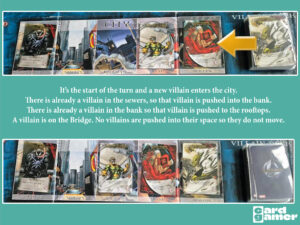
If you’re playing with four or five players, it’s recommended that you don’t draw a card from the Villain Deck until everyone has had their first turn. This is an optional rule, added during later editions of the game. Higher player counts in Marvel Legendary tend to be more difficult, as it takes longer for all of the different players to set their decks up and get their game plans online. This optional rule balances things out and gives players breathing space in the early game.
Play Cards from Your Hand
Playing cards allows you to activate their effects, and to generate resources.
Cards in Marvel Legendary generate one of two currencies when you play them: Recruit or Attack. Recruit is represented by a star symbol and attack is represented by three red slash marks. At the start of the game your deck will only contain S.H.I.E.L.D. Agents who each generate one Recruit, and S.H.I.E.L.D. Troopers who each generate one attack.
New Heroes can be bought from the HQ during your turn using Recruit. Their cost is listed in a yellow circle in the bottom right corner of the card. Any new Heroes you purchase go into your discard pile. Whenever you buy a Hero, place a new card from the top of the Hero Deck into the HQ immediately to replace them. This ensures that the HQ always contains five Heroes for purchase. You also always have the option of buying a S.H.I.E.L.D. Officer for three Recruit. Take them from the top of the S.H.I.E.L.D. Officer pile and put them into your discard pile. S.H.I.E.L.D. Officers generate two Recruit and can be used to help you buy more expensive Heroes.
You can spend the Attack generated by cards you play to fight enemies. Villains, Henchmen, and Masterminds all have an Attack value in their bottom right-hand corner. If the amount of attack that the cards you have played generates equals or exceeds this number then you can fight the enemy. Activate any Fight effects on the card and then take it and put it into a Victory Pile in front of you. You also place any Bystanders captured by that Villain into your Victory Pile.
It’s possible to purchase multiple Heroes and fight multiple Villains, so long as you have the resources to do so. You also don’t have to play every card in your hand if you don’t want to.
Some cards don’t generate resources, they just have effects, such as drawing you more cards.
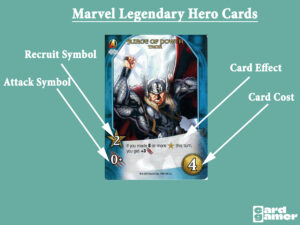
Discard Your Hand and Draw a New Hand of Six Cards
Once you’ve played your cards for the turn, place them, along with any unplayed cards from your hand, into your discard pile. Then draw a new hand of six cards.
If your deck is empty and you go to draw another card, shuffle the cards in your discard pile and use them to form a new deck, then continue drawing cards from this deck. In this way, any new Heroes that you have purchased will now be in your deck and ready to be played.
Key Concepts
There are a few more important rules to know when playing Marvel Legendary.
Hero Teams and Classes
![]()
Hero cards in Marvel Legendary belong to one of five classes and one of several teams. A card’s team is represented by an icon in its top left corner. A card’s class is represented by its color and a symbol listed just below its team icon. Cards with a green fist are Strength Heroes, yellow heads represent Instinct Heroes, red arrows represent Covert Heroes, a grey circuit board represents Technology Heroes, and a blue crosshair represents Ranged Heroes.
Many cards have Superpower Abilities that reward you for playing other Heroes from certain teams, or of certain classes, before you play them. This is represented by an icon followed by a colon.
For example, Hulk’s Growing Anger card from the core set is a Strength card. It has a Superpower Ability where it gains an additional point of Attack if you’ve previously played a Strength card on your turn. If you had two copies of this card in your hand, only the ability on the second one would activate, since the Strength cards will have been played prior to the first one.
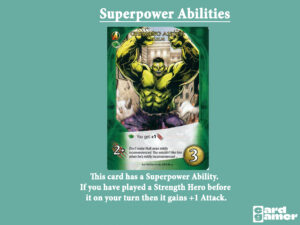
KO-ing cards
Some cards in Marvel Legendary KO other cards. When one of your cards is KO’d, you remove it from your deck permanently and place it on the KO section of the board. While this sounds negative, it’s often beneficial, as it enables you to slim down your deck by removing S.H.I.E.L.D. Agents and S.H.I.E.L.D. Troopers who are less powerful than the cards you recruit later on.
Villains Escaping
As explained in the “Draw a Card from the Villain Deck” section above, Villains and Henchmen gradually move through the city as new Villains and Henchmen are drawn from the deck. The city contains only five spaces; if a Villain is pushed out of the city, typically because they are on the bridge and a new Villain enters their space, then they “Escape” from the city. When a card Escapes, place them sideways on the Escaped Villains section of the board and then resolve their Escape effect (if they have one). The escaping Villain then KO’s a Hero from the HQ with a cost of six or less. The player whose turn it is selects the hero to get KO’d and then replaces them with another Hero from the top of the deck.
If the escaping Villain has captured any Bystanders, then every player must discard a card from their hand as a penalty for failing to rescue them. The captured bystanders go into the Escaped Villains pile. Whether the escaping Villain has only captured a single bystander or several doesn’t matter; players all discard one card either way.
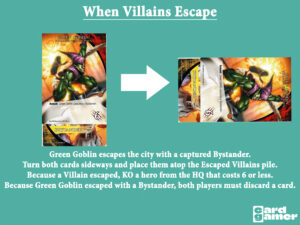
Wounds
Some cards in Marvel Legendary cause players to gain Wounds. When you gain a Wound, place it in your discard pile. Wounds are dead cards that clog up your hand. You can cure your Wounds, and KO them, by not fighting any Villains or recruiting any Heroes during your turn. Later expansions contain more powerful Wounds which are more difficult to cure.
Victory Points
Villains that are beaten, and any Bystanders they have captured, are added to your Victory Pile. Any card that goes in your pile is worth a number of Victory Points. The number of Victory Points a card is worth is listed on its right hand side of the card in a red circle. At the end of the game the player with the most Victory Points wins.
Key Words
Many cards introduced in expansions to Marvel Legendary feature Key Words like Bribe, What if…?, and Size-Changing. These key words impact the game but are not defined on the cards themselves. You can find an explanation in the instruction book included with that expansion.
Winning and Losing the Game
You win Marvel Legendary by defeating the Mastermind. You lose if you’re unable to stop their Scheme. In the event that the Villain Deck runs out of cards then the game ends in a draw.
To defeat the Mastermind, you need to gather enough attack power to equal or exceed the attack value printed on their card. You then declare that you are fighting them and reveal one of their Mastermind tactics. You resolve the tactic’s effect and then add it to your Victory Pile. Once a Mastermind’s fourth and final tactic has been resolved the players win the game. The player taking their turn gets to finish their current turn, then players add up to the total Victory Point value of all of the cards in their Victory Pile. Whoever has the highest total wins.
The loss condition for the game is determined by the Scheme the players are up against. Some Schemes cause the game to end in a failure once a certain number of Scheme Twists have been drawn. Others cause the players to lose if a certain number of Villains escape or if they sustain a certain number of Wounds. Ensure you read your chosen Scheme carefully so that you know how to fight against it.
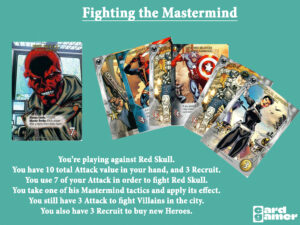
Solo Variant
You can play Marvel Legendary solo by making the following changes during setup:
- Use three sets of Heroes rather than five when putting together the Hero deck.
- Include a single Villain group in the Villain deck; it doesn’t have to be the Villain group that the Mastermind “always leads.”
- Take four Henchman from a single henchman group. Shuffle two of them into the deck, the other two enter the city at the very beginning of the game, activating their Ambush effect if they have one.
- Include a single bystander in the Villain deck, and the typical amount of Master Strikes and Scheme Twists.
You can also play solo by dealing out two starter decks and controlling them both, alternating turns between them.
Conclusion
So there you have it. All of the ins and outs of Marvel Legendary‘s gameplay.
We’ll soon be reviewing all of the Hero and Villain cards from the Core Set to help you make your mind up about how to setup your games. The new Weapon X expansion is also due for release shortly, so we’ll be reviewing that as well.
Keep your eyes here on Card Gamer for all of the Marvel Legendary content that you could ever want.


